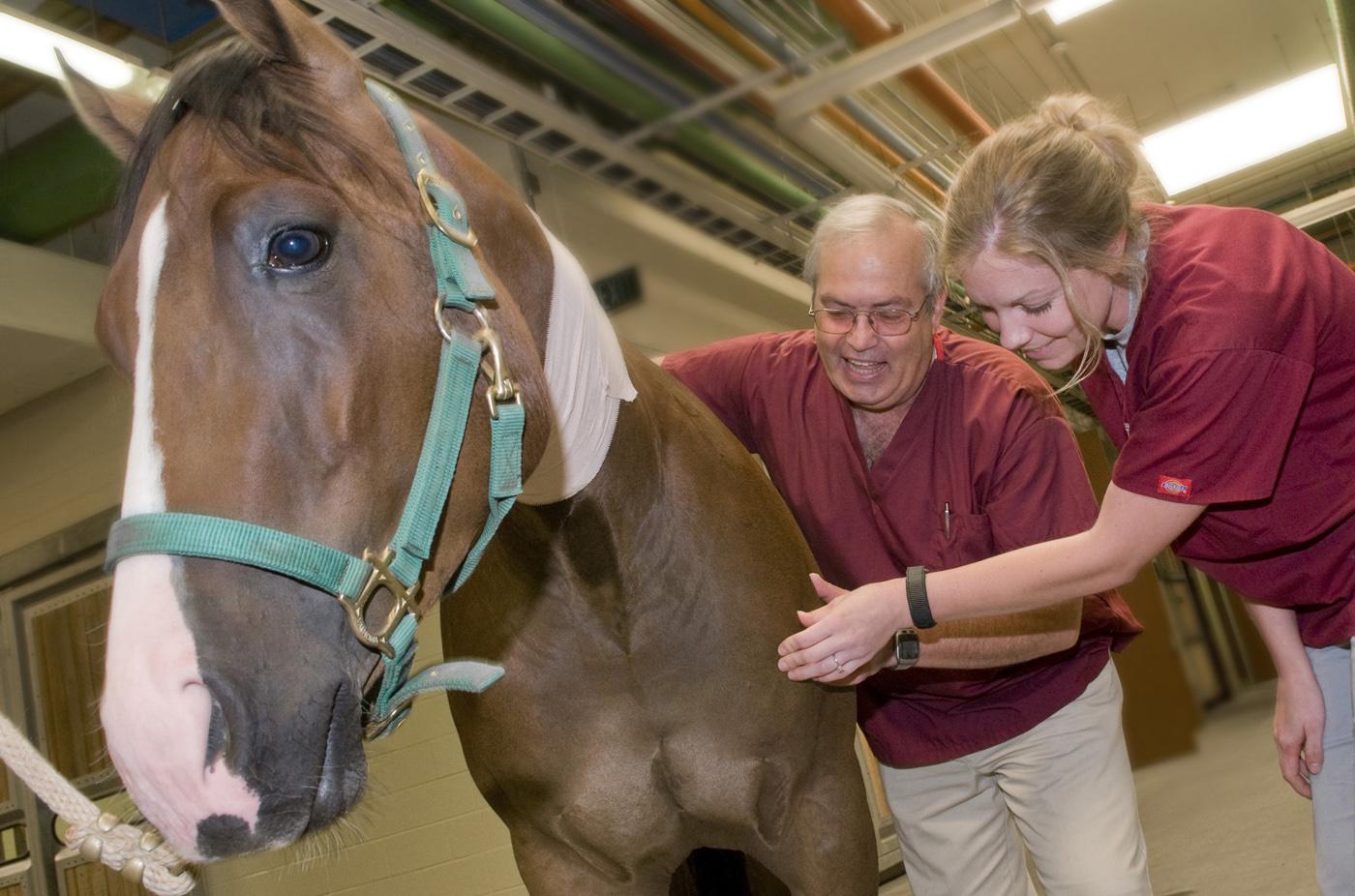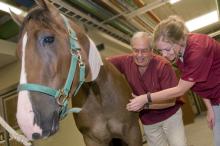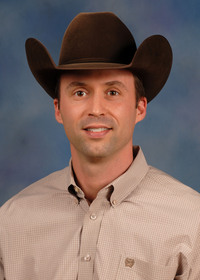Information Possibly Outdated
The information presented on this page was originally released on October 8, 2009. It may not be outdated, but please search our site for more current information. If you plan to quote or reference this information in a publication, please check with the Extension specialist or author before proceeding.
Equine-based programs help people conquer fear of horses
By Patti Drapala
MSU Ag Communications
MISSISSIPPI STATE -- Horses can be intimidating and unpredictable, but Mississippi State University programs that have equine components can help people feel more comfortable with these powerful, large animals.
Animal Health …
Some students at the MSU College of Veterinary Medicine do not have any riding or handling experience with horses. Dr. Bob Linford, a veterinary surgeon and professor, uses his experience as a teacher and horse enthusiast to help them gain confidence.
Students learn applied anatomy as they participate in equine medicine and surgery courses during the second year of veterinary school. They must use their hands to feel a horse’s bones, joints, tendons, connective tissues and muscles.
During the examination, some students feel quite vulnerable kneeling under a full-grown animal that can weigh from 900 pounds to more than 1,200 pounds. Linford and other medical staff do their best to demonstrate safe handling and hands-on examination techniques that can put both humans and horses at ease.
“I have seen fear evaporate in many veterinary medical students once they learn how to approach horses and begin to work with them,” Linford said. “Some of these same students become so comfortable with horses that they later decide to specialize in equine medicine.”
Linford’s responsibilities include teaching courses on equine medicine and surgery. The process of teaching veterinary medical students to treat, save and rehabilitate equine patients is more gratifying for the professor when they share his enthusiasm.
“If physical problems are uncorrected in horses, they often lose their lives,” Linford said. And when horses have medical problems, they do not adjust well to hospitalization and being isolated from other horses. Their social nature is what makes it difficult, but rewarding, to treat them and educate students to be comfortable around them.”
Youth Development …
The social nature of horses and their physical beauty draw many youth to join 4-H so they can participate in the organization’s horse project. Many of these youth and their parents lack experience with horses, which can lead to misunderstanding, disappointment and sometimes injury.
Parents and 4-H members who participate in the horse project learn to proceed slowly in getting close to horses. The program recommends “baby steps” in learning how to approach, train and care for a horse. Youth enlarge their comfort zone by allowing the horse to sniff them, offering a treat and rubbing its neck or mane.
“You just don’t buy a horse and plop a child onto its back,” said Clay County director Donna Cliett of the MSU Extension Service. “People need to understand the nature of horses and the ability of horses to sense unease being projected by humans or other animals that come in contact with them.”
As a 4-H leader, Cliett said she has seen apprehension in some young riders who sign up for the horse project. As youth become used to their horses, they conquer that fear.
“Some children go from being terrified of horses to getting on their horse and becoming a speed demon at barrel and pole racing,” Cliett said.
An avid horse enthusiast since her childhood, Cliett also has seen how distress, such as illness or injury, can quickly change a horse’s disposition.
“In this situation, they can hurt people if not handled properly,” Client said. “Because veterinary medical students receive proper training, they know how to be safe and protect the patient from harm.”
Therapeutic Riding …
Proper handling of horses is just as important when humans have been hurt or suffer from physical or emotional disabilities.
Extension youth development specialist Mary Riley directs the 4-H Therapeutic Riding Program offered to children with special physical or emotional needs. These children become Therapeutic Equestrian Activity Members, or TEAM riders, in the program.
Riley’s approach to horsemanship mirrors that of the 4-H horse project and veterinary medical student training.
“Depending on the child’s size, we accompany or carry them to their horse or carry them and let them touch the horse on its shoulder, neck and head,” Riley said. “I encourage the child to stroke the horse’s muzzle and feel its whiskers and warm breath.”
The therapeutic riding program began in 2000, and Riley said no child has refused to participate after experiencing this approach. Of course the horses selected for the program are patient and get along with people.
“Horses are inherently intuitive, sensitive and alert to their surroundings,” Riley said. “They also are herd animals that respond to leadership, and for this reason, they can be wonderful teachers.”
Intercollegiate Sports …
Many 4-H youth and special needs children who ride horses are beginners who evolve into riders with command of their horses. Some competitors on MSU’s Equestrian Team start out that way, too.
“Some team members have never ridden horses, but intercollegiate equestrian competition includes all levels of expertise, from beginner to expert rider,” said MSU equestrian team coach Molly Nicodemus.
The experienced team members work with beginners to help them feel comfortable being around a horse, and then riding and directing it to perform in the show ring. These riders do not train or compete with the same horse, so they must learn to adapt quickly to unfamiliar horses.
“It’s rewarding to see beginning riders do well,” said Nicodemus, an assistant professor of animal and dairy sciences. “An equestrian team has to have strong riders in each division of competition for the team to do well, so these beginners are just as valuable as the ones with experience.”
Contact: Dr. Bob Linford, (662) 325-3432





